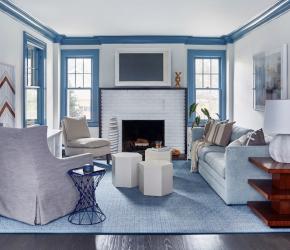Classic
Monochromatic rooms can be a classic if put together properly. Staying with a warm neutral base and layering with textures, artwork, a mix of materials and accent pieces can turn a dull lifeless looking room into an inspiring, livable space. I think the all white and gray look is going by the wayside, as people want their homes to be more comfortable and inviting, instead of stark and sterile looking. So if color is not for you, you can keep the monochromatic look by staying with the warm cozy neutrals and add the touches of color that inspire you and your family. Georgine O’Donnell, O’DESIGNS.
This design scheme will impart sophistication and quiet complexity to a room, garden or home exterior. Picking a single color, varying the tones and adding different textures and sheens will create the interest in place of multiple colors. This will always be a staple in the world of design. Janice Bohn, Anne Marie Design Studio.
I feel that monochromatic rooms are classic. Clients enjoy peaceful rooms that are not jarring, that bring calm and welcome relaxation. Using many shades of a single color can often accomplish this. I'm very happy to see that the trend right now is to use this style with color rather than shades of white and neutrals. Teddy Karl, The Great Cover-Up.
I think color will always be around, whether it’s the main furniture piece, wall paint color or a throw pillow. Clients that went to monochromatic rooms years ago are now adding lots of color again. And clients that had a lot of color are going more monochromatic, but still adding color with accessories and pillows. Pamela Calvert, Pamela Calvert Designs.
A monochromatic room can be chic and interesting when it’s done right. The depth of the hue will depend on the vibe of the room (i.e., moody, happy, energetic, serene, ethereal, etc.). To keep the space interesting and the eye moving around the room, it is important to use different shades of the hue and layer in loads of texture. Monochromatic rooms have been a favorite for many years and will continue to be a classic design element; select the color and go for it! Barbara Collins, Barbara Collins Interior Design.
Neither
A monochromatic color scheme, regardless of room, is neither classic nor craze. It is personal. Just as color preferences go, starting from a young age, so are the energy levels in a room. A calm space typically calls for a single hue first and foremost. Choose THE hue then layer it with its own highlights and lowlights, tints and shades to create contrasts of interest. Need a little more punch? Mix in textures and patterns in the same monochromatic scheme. With the proper color formula, the monochromatic room will never grow old. Good design never does. Geri Hayes, Ideas Only: Color Light Design.





